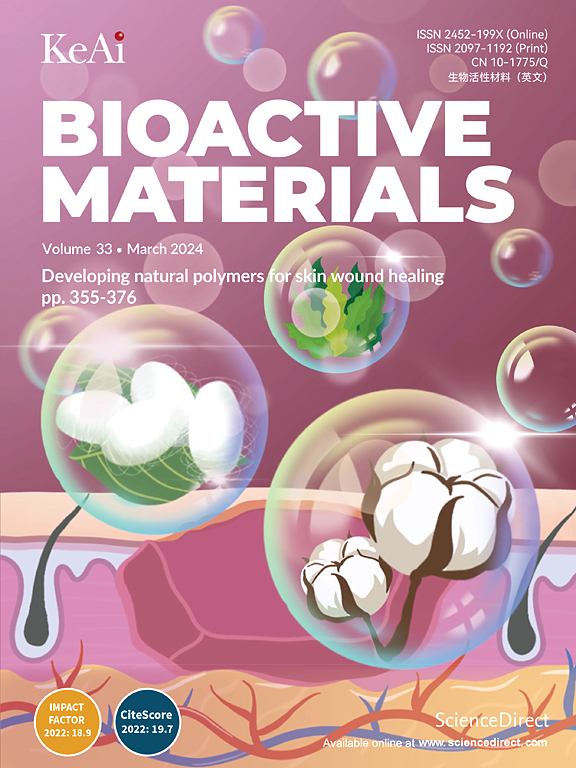Artificial multienzyme nanoflower composite hydrogel for efficiently promoting MRSA-infected diabetic wound healing via glucose-activated NO releasing and microenvironment regulation
IF 18
1区 医学
Q1 ENGINEERING, BIOMEDICAL
引用次数: 0
Abstract
Diabetic wound repair is a global challenge due to bacterial infection and the typical microenvironments of hyperglycemia, high pH value, hypoxia, persistent inflammation and insufficient angiogenesis. Herein, a glucose-activated nitric oxide (NO) releasing and microenvironment regulation hydrogel dressing (COH-GB) has been developed for efficiently promoting infectious diabetic wound healing. Specifically, an artificial multienzyme nanoflower (GB nanoflower) composed of glucose oxidase (GOx) and hemoglobin (Hb) was synthesized and incorporated into the hydrogel formed by carboxymethyl chitosan (CMCS), oxidized sodium alginate (OSA) and hydroxyurea (HU). In which, the hyperglycemia-triggered cascade reaction could consume glucose, while providing hydrogen peroxide (H2O2) for the generation of NO by HU in the presence of Hb with peroxidase-mimicking activity. The COH-GB hydrogel with essential wound dressing characteristics could remodel the microenvironment of diabetic wounds by reducing local glucose and pH levels, alleviating hypoxia, and scavenging excessive ROS; and releasing NO under different blood glucose levels for antibacterial or angiogenesis. Importantly, the prepared COH-GB hydrogel significantly accelerated the MRSA-infected diabetic wound healing by effectively reducing wound infection, inhibiting inflammation, and promoting collagen deposition, angiogenesis and the migration and differentiation of fibroblasts and keratinocytes. Notably, the formation of GB nanoflowers could enhance the activity and stability of enzymes, and improve the cascade reaction efficiency, thereby inducing a more efficient performance in microenvironment regulation, antibacterial and angiogenesis, as well as wound healing. Hence, the prepared artificial multienzyme nanoflower composite hydrogel provides an efficient and secure dressing for promoting infectious diabetic wound healing via glucose-activated NO releasing and microenvironment regulation.

人工多酶纳米花复合水凝胶通过葡萄糖激活NO释放和微环境调节有效促进mrsa感染的糖尿病伤口愈合
由于细菌感染和典型的高血糖、高pH值、缺氧、持续炎症和血管生成不足的微环境,糖尿病伤口修复是一项全球性的挑战。本研究开发了一种葡萄糖活化一氧化氮(NO)释放和微环境调节水凝胶敷料(COH-GB),可有效促进感染性糖尿病伤口愈合。合成了由葡萄糖氧化酶(GOx)和血红蛋白(Hb)组成的人造多酶纳米花(GB纳米花),并将其掺入羧甲基壳聚糖(CMCS)、氧化海藻酸钠(OSA)和羟基脲(HU)形成的水凝胶中。其中,高血糖触发的级联反应可以消耗葡萄糖,同时在具有过氧化物酶模拟活性的Hb存在的情况下,为HU生成NO提供过氧化氢(H2O2)。具有必要创面敷料特性的COH-GB水凝胶可以通过降低局部葡萄糖和pH值、缓解缺氧、清除过量ROS来重塑糖尿病创面微环境;并在不同血糖水平下释放NO用于抗菌或血管生成。重要的是,制备的COH-GB水凝胶通过有效减少伤口感染,抑制炎症,促进胶原沉积,血管生成以及成纤维细胞和角化细胞的迁移和分化,显著加速mrsa感染的糖尿病伤口愈合。值得注意的是,GB纳米花的形成可以增强酶的活性和稳定性,提高级联反应效率,从而在微环境调节、抗菌和血管生成以及伤口愈合方面具有更有效的性能。因此,制备的人工多酶纳米花复合水凝胶通过葡萄糖激活NO释放和微环境调节,为促进感染性糖尿病伤口愈合提供了一种高效、安全的敷料。
本文章由计算机程序翻译,如有差异,请以英文原文为准。
求助全文
约1分钟内获得全文
求助全文
来源期刊

Bioactive Materials
Biochemistry, Genetics and Molecular Biology-Biotechnology
CiteScore
28.00
自引率
6.30%
发文量
436
审稿时长
20 days
期刊介绍:
Bioactive Materials is a peer-reviewed research publication that focuses on advancements in bioactive materials. The journal accepts research papers, reviews, and rapid communications in the field of next-generation biomaterials that interact with cells, tissues, and organs in various living organisms.
The primary goal of Bioactive Materials is to promote the science and engineering of biomaterials that exhibit adaptiveness to the biological environment. These materials are specifically designed to stimulate or direct appropriate cell and tissue responses or regulate interactions with microorganisms.
The journal covers a wide range of bioactive materials, including those that are engineered or designed in terms of their physical form (e.g. particulate, fiber), topology (e.g. porosity, surface roughness), or dimensions (ranging from macro to nano-scales). Contributions are sought from the following categories of bioactive materials:
Bioactive metals and alloys
Bioactive inorganics: ceramics, glasses, and carbon-based materials
Bioactive polymers and gels
Bioactive materials derived from natural sources
Bioactive composites
These materials find applications in human and veterinary medicine, such as implants, tissue engineering scaffolds, cell/drug/gene carriers, as well as imaging and sensing devices.
 求助内容:
求助内容: 应助结果提醒方式:
应助结果提醒方式:


